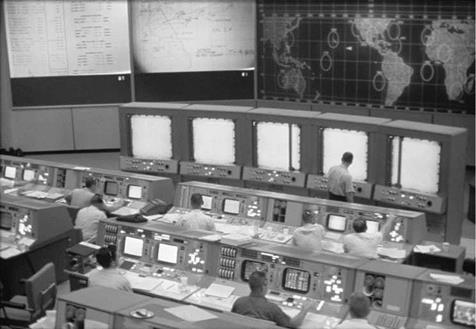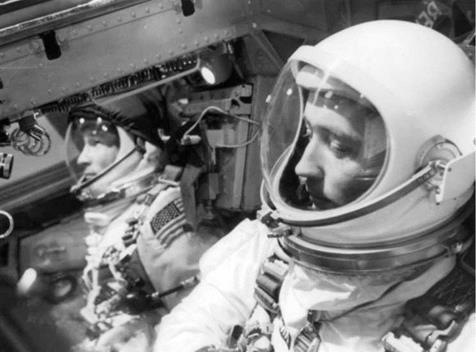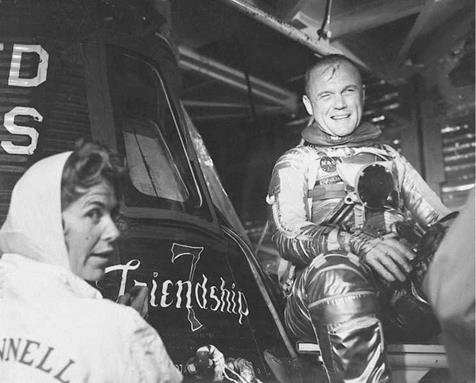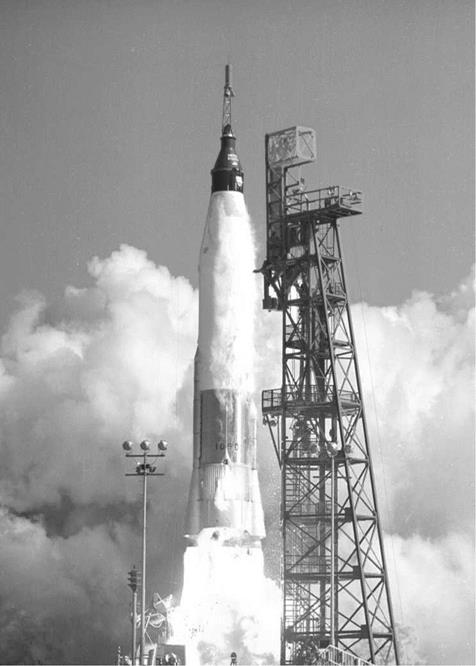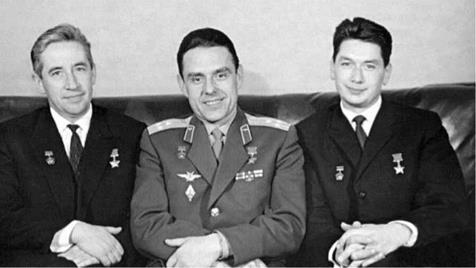ONWARD, UPWARD… AND OUTSIDE
As remarkable a success as Gemini 3 had been, it had been overshadowed, five days earlier, by Alexei Leonov’s spacewalk. Admittedly, NASA had its own plans for astronaut Pete Conrad to perform a short, ‘stand-up’ EVA on Gemini V that summer, but the Voskhod achievement encouraged the agency to move its own spacewalk forward to the next Gemini, by now redesignated with Roman numerals as ‘Gemini IV’. This proved good news for the crew of that flight, Jim McDivitt and Ed White, but continuing problems with the certification of General Electric’s fuel cells had already halved their mission from seven to four days. The long-duration flight would now be rescheduled for Gemini V, as would the Rendezvous Evaluation Pod (REP), although McDivitt and White would still come close to the five-day record set by Valeri Bykovsky at the end of Vostok 5 and would mark an enormous leap for the United States.
It would come as something of a disappointment for Wally Schirra and Tom Stafford, who, on 15 April 1965, finished their duties backing up Grissom and Young and were named as the prime crew of Gemini VI, planned for later that year. At one stage, this mission was expected to conduct not only the first rendezvous with an Agena-D target, but Stafford would make the United States’ first EVA. The spacewalk was subsequently moved to Gemini V and Pete Conrad, before the Voskhod 2 surprise prompted NASA to provide extravehicular suits for White instead. Then, to Stafford’s chagrin, the planners began talking of accelerating the rendezvous, with McDivitt and White performing station-keeping manoeuvres with the second stage of their Titan II. “It looked as though we weren’t going to be left with any new challenges,” Stafford wrote, “though I was puzzled by the claim that station-keeping with an upper stage was a ‘rendezvous’.’’
Schirra viewed things differently. Conservative in his approach, he was reluctant to complicate his already-complex rendezvous mission with an EVA. He and Stafford both knew how crucial rendezvous was to a lunar landing; if they could not make it work, the chances of meeting John Kennedy’s end-of-the-decade goal would be severely jeopardised. Little did either man know at the time, but Gemini VI would indeed achieve the world’s first space rendezvous. . . albeit with a somewhat different target.
On the ground, meanwhile, the new Mission Operations Control Room (MOCR) in Houston was slated to assume day-to-day command of future missions, taking over from the updated Mercury Control at Cape Kennedy, which had run Gemini 3. From the MOCR, Lead Flight Director Chris Kraft would oversee three shifts – his own, focusing on the flight schedule, that of Gene Kranz, to track systems performance, and finally that of John Hodge, to manage real-time mission planning – and the force of controllers tiered beneath them included experts on virtually every component within the Gemini capsule and its Titan II booster. They, in turn, had direct links to their own support teams, scattered in plants and factories throughout the United States.
McDivitt and White were assigned to Gemini IV on 27 July 1964, with Frank Borman and Jim Lovell as their backups. The prime crew had known each other since their days at the University of Michigan, from which McDivitt graduated in 1959 with a bachelor’s degree in aeronautical engineering, the same year that White received his master’s in the same field. Borman and Lovell first met during the 1962 selection process and would fly two missions together; in fact, both born in March 1928, both blue-eyed, both of equivalent rank in their respective services, they were about as close to twins as unrelated astronauts could get.
Except, perhaps, for the close parallels between McDivitt and White. Barely a year separated the two men in age and both were married to women named Pat. Both had earned their aeronautical engineering degrees from the same institution and in the same year, after which both completed test pilot training at Edwards Air Force Base in California and secured approximately the same amount (around 2,000 hours) of experience in jets. Both also wore the gold leaf of a major in the Air Force at the time of Gemini IV. Above all, both had applied for, and been selected to join, the second group of astronaut candidates in September 1962. ‘‘Jim and I have
|
The Mission Operations Control Room at the Manned Spacecraft Center (MSC) in Houston. |
been following right along together,” White once said. “It seems that every time we got together we were taking examinations of some kind.” Their biggest test still lay ahead of them.
Among their earliest jobs was a thorough review of the Gemini IV spacecraft, whose construction in St Louis had met with delay following a shortage of parts. Not until November 1964, when the Gemini mission simulator became available in Houston, could they begin direct training… and lobbying. In fact, it has often been remarked that, without McDivitt and White’s determination in getting the EVA added to their mission, the G4C extravehicular suit might not have been available to be assigned to Gemini IV. This determination, wrote Barton Hacker and James Grimwood in their 1977 history of Project Gemini, showed that the astronauts’ role in the decision-making process “went far beyond that of the normal test pilot in determining what was to be done and when’’. Still, when NASA announced in May 1965 that White would indeed venture beyond the pressurised confines of his spacecraft’s cabin, some observers felt it was little more than a ploy to keep up with the Soviets.
In reality, spacewalking had been a major goal of the project virtually from its conception and the public had drawn a link between EVA and Gemini IV since McDivitt and White’s assignment to the mission. At the July 1964 press conference to announce their selection, Gemini’s deputy manager Kenny Kleinknecht had announced that one of the astronauts might open the hatch and stick his head outside. Even earlier, in January, a plan for EVA operations had flagged Gemini IV as the possible first flight to incorporate some kind of extravehicular activity, although, at the time, the availability and development of the required equipment presented a real question mark. As the year progressed, the situation improved: the AiResearch Manufacturing Company was contracted to build a shoebox-sized chest pack for White’s space suit, the David Clark Company received specifications to build the bulky all-white ensemble itself and McDonnell set to work modifying the Gemini IV capsule to support an extravehicular option.
Altitude chamber tests of the spacecraft in November provided an opportunity to quieten the naysayers in MSC’s Crew Systems Division, who felt a spacewalk should not be attempted until the astronauts had endured ‘realistic’ simulations on the ground. However, McDonnell had their own reservations. They did not want to risk injuring astronauts in the altitude chamber and, said John Young, many within NASA were none too happy about ‘‘putting guys in vacuum with nothing between them but that little old lady from Worcester, Massachusetts [the David Clark seamstress] and her glue pot and that suit’’. Nevertheless, the test went ahead, at 12,000 m altitude conditions, although the first EVA attempt left something to be desired when the astronauts could not close the hatch properly.
The suit itself was basically the same as that worn by Grissom and Young on Gemini 3, with the exception that it had redundant zippers, a pair of over-visors for visual and physical protection, automatic-locking ventilation settings and a heavier outer covering. Shortly after Voskhod 2, efforts gathered pace when MSC Director Bob Gilruth and his deputy, George Low, reviewed a hand-held manoeuvring device, which finally convinced the higher echelons of management that an EVA on Gemini IV was a realistic option.
By the end of April 1965, a model spacecraft had been installed in MSC’s vacuum chamber for advanced testing, and in mid-May Gilruth received the staunch support of Bob Seamans, who in turn described the plan to Jim Webb and his deputy, Hugh Dryden. One note of contention came from NASA’s manned spaceflight chief, George Mueller, who doubted that the EVA hardware could be ready in time for June, but was appeased on 19 May when Charles Mathews announced that all equipment for White’s excursion was ready to go. Webb supported the plan for Gemini IV, but Dryden felt it gave the impression of a knee-jerk reaction to Voskhod 2. However, after Webb asked Seamans to prepare a report on the need for an early spacewalk, Dryden relented and gave his approval. That approval, scribbled in the corner of Seamans’ report, was given on 25 May. Nine days later, Gemini IV was ready to fly.
Questions remained, however, over when to announce the EVA: before, during or after the event. Despite early plans in April to announce it at a news conference, if it was approved, NASA’s policy of openness obliged the agency to include it in their Gemini IV press kit. When the latter was published on 21 May, it included reference to a ‘‘possible extravehicular activity’’, which the press learned had become a certainty after its final approval by Webb and Dryden. Nor would it be a relatively puny case of White pushing open the hatch and poking his head into space: he would actually leave Gemini IV and manoeuvre around with the aid of the hand-held
|
Interior view from Gemini IV, showing McDivitt in the foreground and White behind. Note the cover over White’s tinted visor. |
propulsion device. This device, it was further added, could be used to move himself over to inspect the just-jettisoned second stage of the Titan II. Gilruth and Low had first latched onto this idea shortly after Gemini 3 arrived in orbit, when Capcom Gordo Cooper suggested that Grissom try to ‘rendezvous’ with the Titan, and lent their support for such a station-keeping exercise on McDivitt and White’s mission.
The plan was for McDivitt to match his spacecraft’s velocity with that of the second stage – a relatively short distance away and in the same orbital plane – and evaluate his ability to station-keep. Lack of a rendezvous radar on Gemini IV made the task more complex and, although Martin installed flashing lights on the GLV-4 rocket’s second stage, the two astronauts would have to rely upon their own eyes as navigational aids. Further, they had no way of rehearsing such a station-keeping exercise in the ground-based simulators; at least, that is, until McDonnell engineered a mockup view of the target against a starry backdrop.
In addition to station-keeping and the spacewalk, Gemini IV would attempt the longest American manned spaceflight to date. As far back as August 1964, Charles Mathews had announced that the unavailability of fuel cells would render it a four – day, battery-reliant flight. Another reason, McDivitt explained, could have been that only enough food was packed aboard the spacecraft ‘‘for two normal people’’ for four days. Unable to resist, backup pilot Jim Lovell quipped: ‘‘And these two ain’t normal!’’
Discipline, persistence, dedication 253
However, Chuck Berry, in charge of all Project Gemini medical matters, was reluctant to give his blessing for such a long mission: cardiovascular problems, he noted, had cropped up in the final Mercury-Atlas flights and it was feared that McDivitt and White’s bodies would be subjected to the same kind of physiological strain as that imposed by prolonged bedrest, followed by immediate and vigorous physical exercise. Four days in weightless conditions, Berry argued, could decondition the men to such an extent that they might not be able to withstand the stresses of re-entry, perhaps even losing consciousness. As a result, bungee cords requiring a force of 32 kg to fully extend would be carried for McDivitt and White to exercise their upper-body muscles.
For all of its goodies – rendezvous, long-duration flight, spacewalking – one of the things that Gemini IV lost was the chance for its astronauts to give it a name. Gus Grissom’s choice of ‘Molly Brown’ had not gone down well with NASA management and, despite McDivitt’s proposal of a patriotic ‘American Eagle’, a firm stance was maintained: the mission would be known simply as ‘Gemini IV’. (Ironically, in the wake of Gemini 3, even President Johnson congratulated Grissom on the success of ‘Molly Brown’, remarking that she ‘‘was as unsinkable as her namesake.’’) Instead, McDivitt and White insisted that they wear American flags on the sleeves of their space suits, making them the first United States astronauts to do so. Their crew patch, though, bore only the name ‘Gemini IV’. At a press conference, when asked if he intended to name his spacecraft, McDivitt responded: ‘‘Don’t know. What’s playing on Broadway these days?’’











